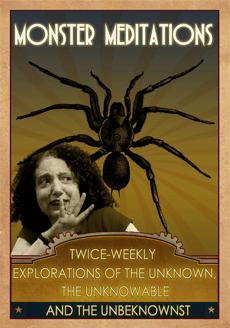Plays within plays, stories within stories, dreams within dreams… It’s a classic for storytellers of all kinds. I’ll admit to using dreams in fiction to communicate with the reader. The character, the dreamer, may or may not understand the images and fragments of conversation that linger in the morning after a dream — but the reader may be more adept at interpreting unconscious messages.
In one of my unpublished novels — my attempt at urban fantasy/vampire romance that may never see the light of day (or deepest night) — the heroine would very much like to plunge ahead into an intense affair with the charming vampire. But he is a reluctant lover. He has valid reasons for slowing down the fun. His romantic track record is particularly dreadful. So the romance in the novel was relegated to sexy dreams.
Maybe that’s why the book didn’t work?
I think I’ve had more success with stories within stories. Characters reveal themselves in the stories they tell each other. It could be as simple as a parent reciting a favorite fairy tale to a child at bedtime. The choice of the story reveals what’s important to the parent. Is it Cinderella or Beauty and the Beast? Or, perhaps, this parent is struggling with the consequences of a deal made with the devil and chooses to tell Rumpelstiltskin to the child?
In my first MONSTER — The Mary Shelley Game — the characters share their own Frankenstein-themed stories at a weekend party in the country. This was inspired by the house party where Mary Shelley wrote her first draft of her masterpiece. It was a rainy weekend and the erudite guests decided to write ghost stories for entertainment. What a great idea if your guests include noted poets! I really enjoyed imagining the stories written by the characters — especially the more competitive characters. My aim was to have the stories within the story work independent of the overall text. It was challenging and fun.
Perhaps the most famous play within a play gambit is Shakespeare’s play within Hamlet.
May be the devil, and the devil hath power
T’ assume a pleasing shape. Yea, and perhaps
Out of my weakness and my melancholy,
As he is very potent with such spirits,
Abuses me to damn me. I’ll have grounds
More relative than this. The play’s the thing
Wherein I’ll catch the conscience of the king.
From Hamlet





Shakespeare really worked the whole idea of a play within a play. You’re wise to take a cue from the Bard!
Always wise to listen to the Bard!
I’m going to see Alan Cummings new Macbeth in two weeks. He plays ALL the roles. It’s supposed to be amazing.
Have you noticed the chapter titles in Waltzing in the Snow? They are all twisted Shakespeare quotes.
Hamlet is my favourite Shakespearian tragedy and I love the device of having a play within the play. Isn’t it amazing that something so old can still seem so modern and innovative? I guess that’s the definition of universal. 🙂
I’m doing a guest blog post about using the classics for inspiration and Shakespeare is one of the top sources. Totally contemporary and yet timeless.
I’ve used dreams in some of my books to provide foreshadowing, or toy with a cluse at the subconscious level. I’ve always worried that the dream sequence concept might be a bit cheesy. So I keep them short. But personally, I think dreams are interesting!
That’s the essential problem with using dreams. We intuitively know they are powerful communicators, but we also remember the stupid uses like on the TV show Dallas… Boy that certainly put a wrench in subsequent uses of dreams in fiction!